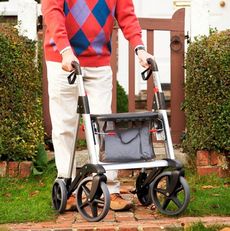1. Make arrangements to meet up for your walk with someone else or a group of similar ability as yourself. It is easier to get going when there is someone else there to help you stay motivated.
2. Look out for walking events and groups in your area, check your health or community centre, local supermarket or online for organised walking groups – both those using walkers and those not.
3. If you find there are no suitable walking groups or activities in your area, take the initiative and speak to your doctor, healthcare professional and friends about starting a walking group – perhaps one specifically for those using walkers (rollators).
4. Arrange to meet friends or family in the park instead of at home or find open gardens to visit, they usually have wheel ramp access which works fine for 4-wheel walkers as well.
5. Help others - ask friends or neighbours if they need anything from the shops, that way it is more difficult to say 'I'll go tomorrow'. You can add a bag (from optional accessories) to the front of the Active Walker for extra storage.
6. Visit areas of natural beauty (and this includes cityscapes!). The Active Walker features a kerb climber which saves you lifting the rollator, instead you step on the kerb climber and gently pull back to step over kerbs and thresholds.
7. Get to know your local area and find parks and walking routes that you feel safe and comfortable with. The local library usually have maps and notice boards with information about your area. It may be a good idea to take someone with you the first time you try out a new route with your walker.
Before starting a more active lifestyle and exercise it is important that you check with your doctor or healthcare professional, they will be able to help you decide at what level you should start and how to best progress.
2. Look out for walking events and groups in your area, check your health or community centre, local supermarket or online for organised walking groups – both those using walkers and those not.
3. If you find there are no suitable walking groups or activities in your area, take the initiative and speak to your doctor, healthcare professional and friends about starting a walking group – perhaps one specifically for those using walkers (rollators).
4. Arrange to meet friends or family in the park instead of at home or find open gardens to visit, they usually have wheel ramp access which works fine for 4-wheel walkers as well.
5. Help others - ask friends or neighbours if they need anything from the shops, that way it is more difficult to say 'I'll go tomorrow'. You can add a bag (from optional accessories) to the front of the Active Walker for extra storage.
6. Visit areas of natural beauty (and this includes cityscapes!). The Active Walker features a kerb climber which saves you lifting the rollator, instead you step on the kerb climber and gently pull back to step over kerbs and thresholds.
7. Get to know your local area and find parks and walking routes that you feel safe and comfortable with. The local library usually have maps and notice boards with information about your area. It may be a good idea to take someone with you the first time you try out a new route with your walker.
Before starting a more active lifestyle and exercise it is important that you check with your doctor or healthcare professional, they will be able to help you decide at what level you should start and how to best progress.


 RSS Feed
RSS Feed
